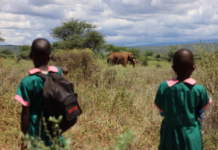By Mary Mwendwa.
They are nature’s most successful scavengers, who provide one of the most important yet underappreciated ecosystem service through direct consumption of carcasses which keeps the environment free from foul smell and risks of rotting carcasses. This important role may just disappear with time if drastic measures are not taken to protect Vultures from Extinction.
Africa’s largest and most recognizable species of Vultures are said to be facing a high risk of extinction, conservationists have warned.
Poisoning and use of vulture body parts and are believed to be some of the main causes of the decrease in vulture populations in Africa. Another worrying threat is the deliberate elimination of vultures as they can alert authorities to illegally killed game carcasses.
Six out of the eleven species most of which are birds of prey are feared to be decreasing in numbers according to the latest reports of birds done by BirdLife International for the IUCN Red List of Threatened species. The IUCN Red List of Threatened Species™ (or the IUCN Red List) is the world’s most comprehensive information source on the global conservation status of plant and animal species. It is based on an objective system for assessing the risk of extinction of a species should no conservation action be taken. www.iucnredlist.org.
Indeed, the Red List Index for vultures in Africa shows that there has been a steady and continuing deterioration in the status of the world’s vultures between 1988 and 2012 . In West Africa, vulture numbers have fallen by 95% over the past 30 years. In South Africa, the Bearded vulture’s population has halved to c.100 pairs and Cape vultures have declined by 60-70% in the last 20-30 years. There has been a 52% decline over a 30 year period in Gyps vulture numbers in the Maasai Mara ecosystem, the most important area for vultures in East Africa. The Hooded vulture, a widespread human commensal, has declined by an average of 62% across Africa over the past four decades, and much more rapidly in some areas.Studies have also shown that ,White Backed vultures have declined in Sudan and South Sudan , Somalia and but is apparently more stable in Ethiopia , Tanzania , Uganda and across southern Africa where an estimated 40,000 individuals remain .
“In Kenya species of vultures are known for concentration are mainly the Maasai Mara, Laikipia area, Hells Gate National Park, and Kwenia (west of Magadi).”
Vultures were also once abundant in the Tsavos but are no longer that abundant there. We do not have estimates of vulture populations in Kenya; However, based on a road count done in 2010 over a distance of about 2300km, vultures are not that many since on average 4 to 5 individual vultures on average were record every 100 kilometres.’’ Paul Kariuki ,Team leader , Species Science and Information , says.
Hooded Vulture,White –backed Vulture,White –headed Vulture, Rüppell’s Vulture,Cape Vulture and Lappet-faced Vulture most of which are critically endangered , their disappearance have consequences for people.According to Dr Julius Arinaitwe, BirdLife International’s Africa Programme Director “As well as robbing the African skies of one of their most iconic and spectacular groups of birds, the rapid decline of the continent’s vultures has profound consequences for its people – as vultures help stop the spread of diseases by cleaning up rotting carcasses.”
“However, now we are becoming aware of the sheer scale of the declines involved, there is still just enough time for conservationists to work with law-makers, faith-based organizations, government agencies and local people, to make sure there is a future for these magnificent scavengers.”He advises.
Similarly, Simon Stuart , Chair , IUCN Species Survival Commission says ; “Vultures and other birds play a critical role in maintaining healthy ecosystems, their decline can have serious knock-on effects on other species and the many benefits provided by nature. While it is encouraging to see some positive outcomes of conservation action, this update is an important wake-up call, showing that urgent efforts need to be taken to protect these species.”
Vultures are a distinctive, iconic and charismatic component of much of the world’s wildlife, particularly well-known in southern Europe, Africa and South Asia. They also provide critical ecological (or ecosystem) services, and these stem from the birds’ unique way of life. Many animals, including birds, scavenge for part of their diet. However, among all the world’s vertebrate species (around 70,000 known to date), only 23 are restricted to this particular mode of life: the vultures. They are more efficient at cleaning carcasses than most, if not all, other scavengers.To succeed as such ‘obligate scavengers’, they must be specialised, and so they are, to an impressive degree: vultures can resist and possibly detoxify bacterial toxins in rotting flesh that would kill other organisms, with extremely acidic secretions of the vulture stomach (pH 1) can dispose of all but the most resistant spores.
Uneaten livestock carcasses pose a direct threat to human health because they provide a breeding ground for pathogenic bacteria, leading to infections and making them sources of a range of infectious diseases, such as anthrax, tuberculosis, brucellosis and botulism. By removing carcasses rapidly and efficiently, vultures cleanse the environment and help protect humans, livestock and wildlife from infectious diseases , studies have reported. For example ,In Spain avian scavengers are estimated to remove 9.9 million tons of carcasses per year.
However, policy implementation has been noted especially in Kenya where Policies have not really been assessed to determine how they would help protect vultures. “Policies have been noted to be weak with poor regulation and enforcement particularly of the use and sale of agro-chemicals. Ultimately if human-wildlife conflict can be controlled, poisoning will be eliminated from the picture and the threat to vultures in E.Africa significantly reduced. “Warns Kariuki.
Bird conservation projects in Kenya by BirdLife are implemented by Nature Kenya (the BirdLife partner NGO in Kenya). Most of these focus on working with communities, government and other stakeholders to conservation some of the 66 Important Bird and Biodiversity Areas (IBAs) in the country – www.naturekenya.org
In Kenya there are 39 species globally threatened by extinction, of which there are 7 other raptors (other than the vultures): Martial Eagle, Secretary bird, Steppe Eagle, Eastern Imperial Eagle and Greater Spotted Eagle, Saker Falcon and the Sokoke Scops-owl.














